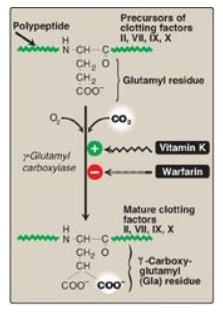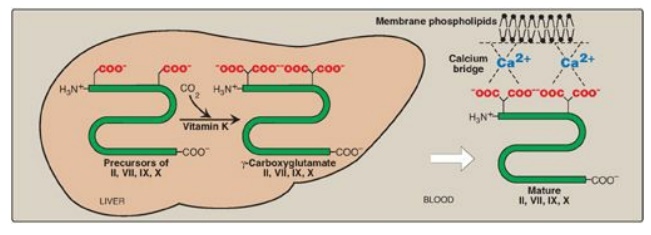Vitamin K
| Home | | Biochemistry |Chapter: Biochemistry : Vitamins
The principal role of vitamin K is in the posttranslational modification of a number of proteins (most of which are involved with blood clotting), in which it serves as a coenzyme in the carboxylation of certain glutamic acid residues present in these proteins.
VITAMIN K
The principal role of
vitamin K is in the posttranslational modification of a number of proteins
(most of which are involved with blood clotting), in which it serves as a
coenzyme in the carboxylation of certain glutamic acid residues present in
these proteins. Vitamin K exists in several forms, for example, in plants as
phylloquinone (or vitamin K1), and in intestinal bacterial flora as menaquinone
(or vitamin K2). A synthetic form of vitamin K, menadione, is able
to be converted to K2.
A. Function of vitamin K
1. Formation of γ-carboxyglutamate: Vitamin K is required in the
hepatic synthesis of the blood clotting proteins, prothrombin (factor II) and
factors VII, IX, and X. (See online Chapter 34.) Formation of the functional
clotting factors requires the vitamin K–dependent carboxylation of several
glutamic acid residues to γ-carboxyglutamate (Gla) residues (Figure 28.26). The
carboxylation reaction requires γ-glutamyl carboxylase, O2, CO2,
and the hydroquinone form of vitamin K (which gets oxidized to the epoxide form).
The formation of Gla residues is sensitive to inhibition by warfarin, a
synthetic analog of vitamin K that inhibits vitamin K epoxide reductase (VKOR),
the enzyme required to regenerate the functional hydroquinone form of vitamin
K.

Figure 28.26 Carboxylation of glutamate to form γ-carboxyglutamate.
2. Interaction of prothrombin with membranes: The Gla residues are good chelators of positively charged calcium ions, because of their two adjacent, negatively charged carboxylate groups. With prothrombin, for example, the prothrombin–calcium complex is able to bind to negatively charged membrane phospholipids on the surface of damaged endothelium and platelets. Attachment to membrane increases the rate at which the proteolytic conversion of prothrombin to thrombin can occur (Figure 28.27).

Figure 28.27 Role of vitamin K in blood coagulation.
3. γ-Carboxyglutamate residues in other proteins: Gla residues are also present in
proteins other than those involved in forming a blood clot. For example,
osteocalcin of bone and proteins C and S (involved in limiting the formation of
blood clots) also undergo γ-carboxylation.
B. Distribution and requirement of vitamin K
Vitamin K is found in
cabbage, kale, spinach, egg yolk, and liver. There is also extensive synthesis
of the vitamin by the bacteria in the gut. The adequate intake for vitamin K is
120 mg/day for adult males and 90 mg for adult females.
C. Clinical indications
1. Deficiency of vitamin K: A true vitamin K deficiency is
unusual because adequate amounts are generally produced by intestinal bacteria
or obtained from the diet. If the bacterial population in the gut is decreased
(for example, by antibiotics), the amount of endogenously formed vitamin is
depressed, and this can lead to hypoprothrombinemia in the marginally
malnourished individual (for example, a debilitated geriatric patient). This
condition may require supplementation with vitamin K to correct the bleeding
tendency. In addition, certain second-generation cephalosporin antibiotics (for
example, cefamandole) cause hypoprothrombinemia, apparently by a warfarin-like
mechanism that inhibits VKOR. Consequently, their use in treatment is usually
supplemented with vitamin K.
2. Deficiency of vitamin K in the newborn: Newborns have sterile intestines
and, so, initially lack the bacteria that synthesize vitamin K. Because human
milk provides only about one fifth of the daily requirement for vitamin K, it
is recommended that all newborns receive a single intramuscular dose of vitamin
K as prophylaxis against hemorrhagic disease.
D. Toxicity of vitamin K
Prolonged administration of large doses of synthetic vitamin K (menadione) can produce hemolytic anemia and jaundice in the infant, due to toxic effects on the membrane of RBCs. Therefore, it is no longer used to treat vitamin K deficiency. No UL has been set for vitamin K.
